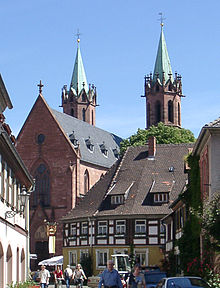Johann II of Fleckenstein
Johann II von Fleckenstein (* in the 14th century; † May 18, 1426 in Ladenburg ) was Prince-Bishop of Worms from 1410 to 1426 .
origin
He came from the Alsatian noble family of the Lords of Fleckenstein and was the son of Heinrich von Fleckenstein and his wife Katharina von Wasigenstein .
Live and act
Johann von Fleckenstein entered the clergy and became provost of the Cyriakus monastery in Neuhausen , as well as to St. Martin and Arbogast in Surburg . He also owned canonicals at the cathedral monasteries in Mainz and Worms.
When the Worms Bishop Matthäus von Krakau died on March 5, 1410, Johann von Fleckenstein was elected as a successor as a compromise candidate on March 12.
At that time the Western Schism existed and three competing Popes ruled. Fleckenstein was a strict supporter of the Roman papal obedience, while the Archbishop of Mainz adhered to the Pisan Pope and therefore did not want to recognize or consecrate Johann von Fleckenstein. Pope Gregory XII. confirmed Fleckenstein's choice on May 15, 1410 and allowed him to be ordained by a bishop of his choice. The Archbishop of Mainz, Johann von Nassau-Wiesbaden-Idstein, urged the city of Worms to reject the new bishop, and a dispute finally arose in 1411, with the mediation of Palatine Elector Ludwig III. was settled. The Worms then paid homage to the new shepherd and he was able to move into the city.
In 1414, Bishop Fleckenstein held a diocesan synod at which he remedied many church grievances and u. a. the Feast of the Visitation of the Virgin Mary and Trinity Sunday became binding. The rights of the Worms Church were also newly described and recorded. This led to new, violent disputes with the city of Worms, especially since King Sigismund supported the positions of the bishop. As a result of the dispute, he now resided in Neuhausen Abbey , and in 1415 he attended the Council of Constance in the wake of the Palatinate Elector . In 1419 Pope Martin V commissioned him to transform the Benedictine Abbey of St. Alban near Mainz into a collegiate monastery . Two warning letters to the city of Worms have been received from 1423, in which the bishop complains that Jews have been refused burial. In 1424 there was a temporary reconciliation with the city, but soon there were violent hostilities again, whereupon Fleckenstein moved permanently to the second residence in Ladenburg and lived in the local bishop's palace . He died here in 1426 and was buried in Worms Cathedral .
From 1412, Johann II von Fleckenstein had a second tower added to the St. Gallus Church in Ladenburg, as this was due for an episcopal residence church. The south tower bears his builder's inscription, the north tower was later rebuilt and adapted to this. The distinctive towers are now the city's landmarks and have also been incorporated into its coat of arms.
In 1423, Bishop Fleckenstein appeared as a councilor for the Electoral Palatinate . His nephew Heinrich von Fleckenstein held the same office and was married to a niece of the Speyer bishop Raban von Helmstatt .
literature
- Friedhelm Jürgensmeier : The Diocese of Worms from Roman times to its dissolution in 1801 , pages 127-131, Echter Verlag, Würzburg, 1997, ISBN 3-429-01876-5
- Johann Samuelersch, Johann Gottfried Gruber: General Encyclopedia of Sciences and Arts , Brockhaus Verlag, Leipzig, 1842, 2nd section, 21st part, p. 432; (Digital scan)
- Johann Samuelersch, Johann Gottfried Gruber: General Encyklopädie der Wissenschaften und Künste , Brockhaus Verlag, Leipzig, 1847, 1st section, 25th part, p. 140; (Digital scan with genealogy)
Web links
Individual evidence
- ^ Wilhelm Arnold: Wormser Chronik von Friedrich Zorn , Stuttgart, 1857, p. 175, footnote 1; (Digital scan)
- ^ Max Levy: On the history of the Worms Jewish community , Reprint, 2012, pp. 13–15, ISBN 5876839574 ; (Digital scan)
- ↑ website for St. Gallus Church; Select sub-item "History"
- ^ Franz Joseph Mone: Badisches Archiv zur Vaterlandskunde in All-sided Respect , Second Volume, p. 129, Karlsruhe, 1827; (Digital scan)
- ^ Franz Staab, Thorsten Unger: Empress Adelheid and her monastery founding in Selz: Papers of the scientific conference in Landau and Selz from October 15 to 17, 1999 , Volume 99 of: Publications of the Palatinate Society for the Promotion of Science in Speyer am Rhein , Speyer , 2005, p. 289, ISBN 3932155211 ; (Detail scan)
| predecessor | Office | successor |
|---|---|---|
| Matthew of Krakow |
Bishop of Worms 1410–1426 |
Eberhard von Stettenberg |
| personal data | |
|---|---|
| SURNAME | Fleckenstein, Johann II. Von |
| ALTERNATIVE NAMES | Fleckenstein, Johann von; Fleckenstein, Johannes von |
| BRIEF DESCRIPTION | Bishop of Worms, Canon in Mainz and Worms, provost |
| DATE OF BIRTH | 14th Century |
| DATE OF DEATH | May 18, 1426 |
| Place of death | Ladenburg |


